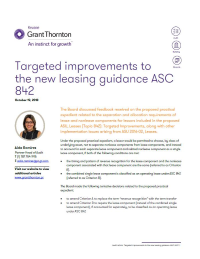-
Financial statements audits
Financial statement audits
-
Compliance audits
Compliance audits
-
Compilations and reviews
Compilations and audit
-
Agreed-upon procedures
Agreed-upon procedures
-
Tax compliance
Business Tax
-
Global mobility services
Through our global organisation of member firms, we support both companies and individuals, providing insightful solutions to minimise the tax burden for both parties.
-
Sales and use tax and indirect taxes
SUT/ VAT & indirect taxes
-
Tax incentives
Navigating the complex landscape of tax incentives in Puerto Rico can be challenging. Whether you're looking to benefit from the Export Services Act (Act 20), the Individual Investors Act (Act 22), or other incentives under Act 60, we provide tailored advice to help you maximize your tax benefits and ensure compliance. Let us help you unlock the potential of doing business in Puerto Rico.
-
Transfer Pricing
The laws surrounding transfer pricing are becoming ever more complex, as tax affairs of multinational companies are facing scrutiny from media, regulators and the public

-
Business consulting
Our business consulting services can help you improve your operational performance and productivity, adding value throughout your growth life cycle.
-
Business Risk Advisory
Risk is inevitable but manageable. We deliver relevant, timely and practical advices to aid organizations manage risk and improve business performance. We can help you identify, understand and manage potential risks to safeguard your business and comply with regulatory requirements.
-
Technology Advisory
We provide comprehensive solutions to safeguard your business and ensure operational resilience and compliance. Our expert team offers a range of technology advisory services designed to address your cybersecurity needs, enhance business continuity, and manage security effectively.
-
Transactional advisory services
Transactions are significant events in the life of a business – a successful deal that can have a lasting impact on the future shape of the organizations involved. Because the stakes are high for both buyers and sellers, experience, determination and pragmatism are required to bring deals safely through to conclusion.
-
Forensic and investigative services
At Grant Thornton, we have a wealth of knowledge in forensic services and can support you with issues such as dispute resolution, fraud and insurance claims.

The Board discussed feedback received on the proposed practical expedient related to the separation and allocation requirements of lease and nonlease components for lessors included in the proposed ASU, Leases (Topic 842): Targeted Improvements, along with other implementation issues arising from ASU 2016-02, Leases.
Under the proposed practical expedient, a lessor would be permitted to choose, by class of underlying asset, not to separate nonlease components from lease components, and instead to account for each separate lease component and related nonlease component as a single lease component, if both of the following conditions are met:
- the timing and pattern of revenue recognition for the lease component and the nonlease component associated with that lease component are the same (referred to as Criterion A).
- the combined single lease component is classified as an operating lease under ASC 842 (referred to as Criterion B).
The Board made the following tentative decisions related to the proposed practical expedient:
- to amend Criterion A to replace the term “revenue recognition” with the term transfer
- to amend Criterion B to require the lease component (instead of the combined single lease component), if accounted for separately, to be classified as an operating lease under ASC 842
- to allow a lessor to account for the combined component of an arrangement qualifying for the practical expedient as a single performance obligation under ASC 606, Revenue from Contracts with Customers, when the nonlease component(s) associated with the lease component is the predominant component of the combined component. Otherwise, the lessor would account for the combined component as an operating lease under ASC 842.
The Board directed the staff to clarify in a final ASU that a lessor would be permitted to apply the practical expedient to combine the lease component and nonlease component(s) qualifying for the practical expedient even when there are nonlease components that are not eligible for the practical expedient within a contract.
The Board also made the following tentative decisions related to transition guidance and the effective date for the proposed leasing improvements:
- a lessor would be required to apply the practical expedient to all existing lease transactions that qualify for the expedient at the date elected.
- the effective date and transition requirements for a final ASU would be the same as those under ASC 842 unless the lessor has already adopted ASC 842, in which case, it would elect the practical expedient either (1) in the first reporting period following the issuance of a final ASU containing the practical expedient, or (2) at the original effective date of ASC 842. Lessors that early adopt the leasing guidance would apply the practical expedient either retrospectively or prospectively.
The Board directed the staff to draft a final ASU related to the proposed practical expedient and the proposed additional (and optional) transition method for adoption of ASC 842 for vote by written ballot.
The Board also discussed additional implementation issues raised by stakeholders related to how a lessor should account for certain lessor costs, such as sales taxes and property taxes and insurance, and agreed with the staff’s recommendation to allow lessors to analogize to certain guidance in ASC 606 when accounting for these costs. The Board tentatively decided to add a separate project to its technical agenda to address these issues.
Source:
Grant Thornton, On the Horizon April 5, 2018.

